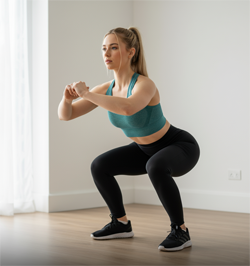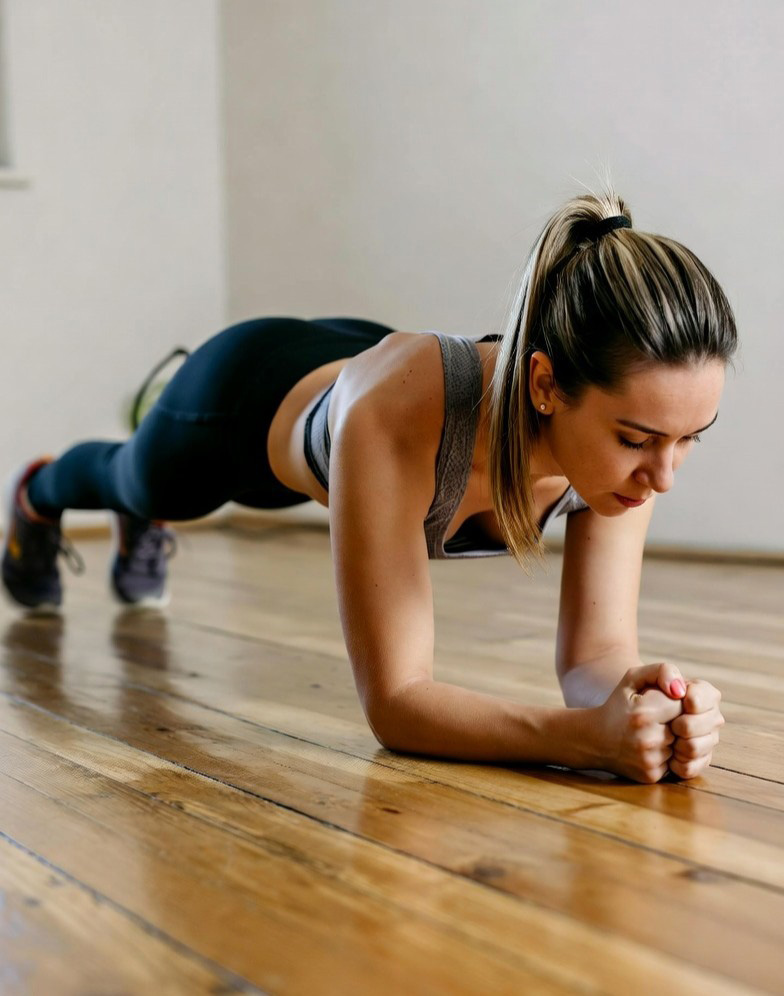For anyone serious about fitness, expert technique correction from a personal trainer is the ultimate key to unlocking lasting progress. The true measure of a successful workout isn’t the quantity of weight you lift, but the quality and precision of every single repetition you perform.
Many people train hard for months or even years only to find themselves stuck on frustrating plateaus, or worse, dealing with nagging pain or injury. The most common cause is either tight muscles or poor technique. When your form breaks down you bypass the target muscle groups. Instead the stress is put onto other muscles or ligaments that aren’t designed to do the job. This simple failure means the difference between guaranteed, lasting progress and an inevitable cycle of frustration and injury. Effective technique correction is not just vital for achieving your goals, it’s a necessity for sustainable health.
As your mobile personal trainer, I see these technical faults daily and bring decades of expertise directly to your home. My goal is to maximise the efficiency and safety of every exercise you do so you get the most benefit.
Table Of Contents
Why My Expertise Is Essential For Every Level
My mobile service is specifically designed to eliminate guesswork and risk from your training. I tailor my approach to your current experience level, ensuring the most efficient and safest path forward.
The Beginner: Building a Flawless Foundation
For the beginner, technique correction is the single most important element. Your initial focus must be on rep quality, not weight quantity.
- The Challenge: You lack the foundational proprioception(1) (internal body awareness) to know when your form is failing. The fear of failure or injury (“gymtimidation”) causes you to rush or compensate. You need clear, simplified instruction to build an accurate movement pattern.
- My Solution: As your personal trainer I establish a private classroom in your home. We start with bodyweight, mastering the perfect squat, romanian deadlift or lunge. If necessary we can also use video to instantly fix errors. My core skill is instilling precise, highly efficient habits through consistent technique correction before any detrimental patterns can take hold.
The Intermediate: Breaking Plateaus & Eliminating Pain
The intermediate client is strong but often stalled. They operate with “good enough” form, but good enough only gets you so far and can often lead to chronic injuries.
- The Challenge: You have likely hit a frustrating training plateau. You experience minor, long-term pain in areas like shoulders, chest or lower back. These are clear symptoms of ingrained technical imperfections that only an external, expert eye can detect.
- My Solution: I conduct a detailed biomechanical audit of your primary lifts. I find the small flaws in your technique such as the slight hip shift or restricted shoulder movement. The seemingly insignificant that is ultimately killing your gains. I introduce advanced concepts like specific rep tempo and refined core bracing to maintain proper posture. Plus as always my comprehensive technique correction diagnoses the underlying mobility or soft tissue restriction. This can be addressed through targeted training, mobility exercises, stretching and potentially massage.
The Veteran: Training Longevity & Peak Performance
The veteran is powerful, but often dealing with compounded physical wear and tear. Years of heavy lifting result in deep-seated compensations and asymmetries.
- The Challenge: You’re lifting heavy, sometimes even extreme. This magnifies the risk of serious injury if form breaks down, even marginally. You carry years of muscular asymmetry, tightness and scar tissue, having subconsciously learned to lift around existing limitations. Effective technique correction becomes a form of high-level risk management.
- My Solution: With over 30 years lifting experience I ensure every rep of every exercise is performed with perfection. My immediate focus is on micro-adjustments during peak effort that eliminate unnecessary shear force and spinal compression. I use my knowledge of biomechanics to pinpoint your structural constraints, whether that’s chronic tightness or muscular imbalances. This ensures that every cue I give you in the moment is perfectly targeted to activate the right muscle and instantly restore optimal alignment under heavy loads. Age is no barrier to lifting – even heavy lifting.
The Mechanics Of Movement Failure
The need for expert technique correction becomes clear when examining the subtle biomechanical failures that plague even the most common exercises.
Technique Correction For Squats
The squat is an excellent exercise for many reasons, yet the smallest mistake triggers a detrimental chain reaction.
The Flaw: Knees Caving In

This is a common technical fault which effects the entire kinetic chain.
- The Biomechanics: The root cause is a failure of the gluteus medius and gluteus minimus to externally rotate the hip. When these critical stabilisers fail to fire, the femur rolls inward, causing the knee to cave inwards.
- The Consequence: This collapse takes the effort away from the powerful gluteus maximus muscle and places significant force on the ACL and MCL ligaments. An injury here can mean surgery and a potentially lifelong weakness.
- The Fix: With detailed technique correction we focus on the correct foot position to help keep your knees in the correct alignment. Plus I check to see if your issue is weak glutes that need isolated training or tight glutes that need massage.
The Flaw: Excessive Forward Torso Lean
This is often a complex problem that is often caused by poor mobility elsewhere.
- The Biomechanics: Limited ankle dorsiflexion (tight calves) means your shins cannot track far enough forward. Can also be due to tight hamstrings or hips. To maintain balance, your body must increase the angle of your torso, shifting the centre of mass forward.
- The Consequence: The load on your lumbar back muscles greatly increases so what should be a safe exercise becomes a path to acute or chronic lower back pain. Potentially this can escalate into a disc or even spinal issues.
- The Fix: Before applying technique correction, we must diagnose the root cause. Whether it is tight hamstrings, ankle mobility, or lack of hip flexibility, targeted stretching is in order. If this isn’t sufficient, deep tissue massage will help speed up the process.
For more on fixing your squat form with massage read this article
Technique Correction For Dumbbell Row
The dumbbell row is a staple for building back width and thickness, but it must be performed with isolation, not momentum.
The Flaw: Excessive Torso Rotation And Momentum
If the weight is too heavy or the lifter begins to tire they often compensate by recruiting the entire upper body, sacrificing isolation.
- The Biomechanics: The lifter initiates the pull with an aggressive rotation of the torso, turning the lift into an uncontrolled heave. This rotation bypasses the powerful latissimus dorsi in favour of smaller muscles like the upper traps.
- The Consequence: Minimal tension is created in the large back muscles you want to develop. The energy is largely wasted on momentum. Plus the repeated rotational strain applied to the lumbar spine under load significantly raises the risk of muscular or even disc issues.
- The Fix: Technique correction establishes lumbar and thoracic core contraction before the movement begins. Among other things I teach you to pull the weight by focusing the path of the elbow toward the hip pocket. This ensures the lats are fully engaged
Technique Correction For The Plank
Even a basic bodyweight exercise like the plank is frequently performed incorrectly, making it useless or even harmful.
The Flaw: Sagging Hips

This signifies the core musculature has switched off, leaving the spine vulnerable.
- The Biomechanics: The rectus abdominis and transverse abdominis fail to maintain the isometric (stationary) contraction required to resist gravity. The spine goes into hyperextension.
- The Consequence: Stress bypasses the abdominal wall and is transferred to the lumbar spine and discs. This results in an anterior pelvic tilt, reinforcing tight hip flexors.
- The Fix: The most essential technique correction cue is active glutes and abdominal engagement. By instructing you to squeeze your glutes and abs we neutralise the lumbar curve and maximally activate the deep core. This will result in a plank with hips that don’t sag and are not raised.
Your Path To Permanent Results
Every repetition you perform with poor technique is not just a wasted movement, it’s a step toward a future injury. You invest significant time, effort and money into your physical health. The most critical, high-leverage investment you can make is in correct technique. It is the singular factor that accelerates your muscle growth, maximises your fat loss and guarantees your long-term health.
Stop guessing your way to injury or frustration. Hire the expertise that brings a dual focus on advanced coaching and therapeutic recovery directly to your safe, convenient home space. Book your first session today!
Book A Personal Training Session
If you would like to book a personal trainer in the York area please contact me on 07713 250352 or email david@massageinyork.co.uk. For more information on booking click here
